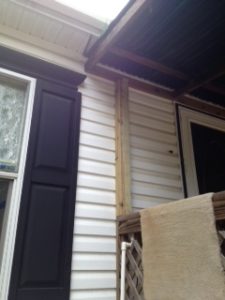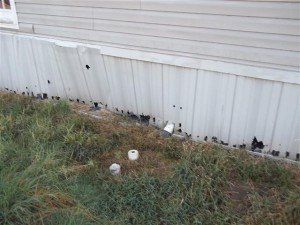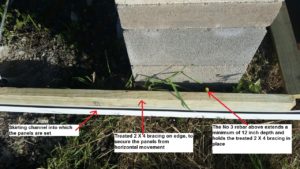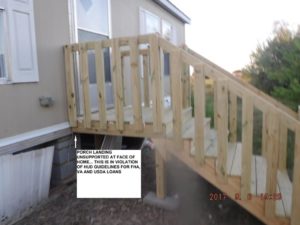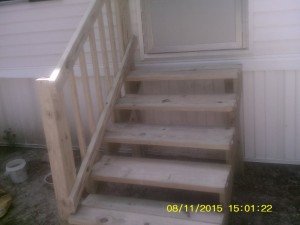Seller Check List for Manufactured Homes
If the manufactured home has been previously issued a Certification Letter by a Texas Registered Engineer attesting that the home meets FHA guidelines from HUD 7584, Permanent Foundations Guide for Manufactured Housing, dated September 1996. and the home owner has possession of it, the home does not need a new inspection or additional modifications (retrofit). The home owner will need an updated report from the same engineer.
If the home owner cannot produce a previously issued Certification Letter by a Texas Registered Engineer attesting that the home meets FHA guidelines or the home has undergone an addition since the original Certification, the home will need to be inspected for compliance and if necessary, retrofit modifications completed to bring the home into compliance.
A common situation is that the home owner cannot find the previous Certification Letter and does not understand why it now does not meet the requirements. Most all the reasons fall into the categories as follows.
- Good engineers who abide as best they can with the vague conflicting guideline interpretations but on rare occasions missed something critical.
- A very small minority of not so good people who will sign off on about anything and not care about anything other than the immediate fee. The Texas Society of Professional Engineers Enforcement Division is very diligent in weeding these guys out of the profession but a very rare few always pop up.
- There may have been rule modifications since the original inspection but because the Certification Letter cannot be located they lose their “grandfathered” eligibility.
We have worked as a team with realtors and brokers for over 20 years, and have learned numerous ways to help bring buyers to the table. We hope the tips below are helpful.
Early in the listing period,
- Seller needs to confirm at the Texas TDHCA website http://mhweb.tdhca.state.tx.us/mhweb/title_view.jsp
- that the manufactured home has been converted from chattel to real estate and
2. Seller needs to produce written documentation that the home has been moved only once… from the dealer lot to the present address… if they cannot, then we can do an inspection and certification letter that states that the home has not been moved since. https://www.tdhca.state.tx.us/mh/docs/1026-formt.pdf
3. If the HUD labels on the outside of the home have been removed or lost and the dealers label inside the home is also missing, start the process with IBTS to get replacement tags… the home cannot close with these missing.
4. If any carport, porch or decking has its rood attached to the home, the seller needs to place support posts (4 X 4’s) to remove the load away from the home.
5. If the skirting has a few panels that are damaged, seller needs to replace them with new ones. A home with major skirting damage does not look good to a buyer and the buyer cannot get financing on the home until the skirting is intact.
6. If the buyer is going FHA on their loan, the skirting also needs to be braced. Seller may want to do this themselves– it requires about $80 to $120 in materials and a half day of labor to do.
7. Drainage away from the crawlspace is very important… if the home is on a downslope in either direction, consider the use of planters across the front or rear as a means to divert rain runoff away from the crawlspace. These planters must run the entire length of the home. In addition, low areas, especially in the front yard, need to be filled in so as to not impound water
8. Check to make sure the tongues and axles have been removed from the home. The home cannot be financed if these are still attached to the home.
9. If there are mortar cracks at the ceiling crown and elsewhere, Seller may need to install concrete footings, one at each corner and two in the center rear and two in the center front to slow down any further settling… these are fairly simple to install and can be done over a weekend.
10. Seller needs to obtain written documentation as to whether his home is in the Flood Plain. A copy of the local Flood Main map showing his street and house location in reference to the nearest 100 year Flood Plain line would be sufficient until a formal survey is done.
11. Deck or porch landings 30 inches and higher need handrails installed with vertical balusters. Balusters need to be spaced 6 inches center to center.
12. Steps that are 30 inches or higher need a handrail on one side, with vertical balusters spaced 6 inches center to center.
13. Leveling is NOT a part of the Retrofit and Foundation Certification Report. Both HUD ( on FHA, VA and USDA loans ) and TDHCA ( conventional loans ) consider leveling to be a maintenance issue and NOT a foundation or structural issue to be covered in any certification report
a. Older manufactured homes used untreated pressboard material for floorboards and those warp very readily when exposed to moisture
b. The only way to determine if a MH is level is to run a level test underneath the MH along the lip of the I beam frame
c. HUD allows up to a 0.5 inch elevation difference 30 feet in any direction
d. If doors or windows have problems opening or shutting, this can be an early indication of a leveling problems

